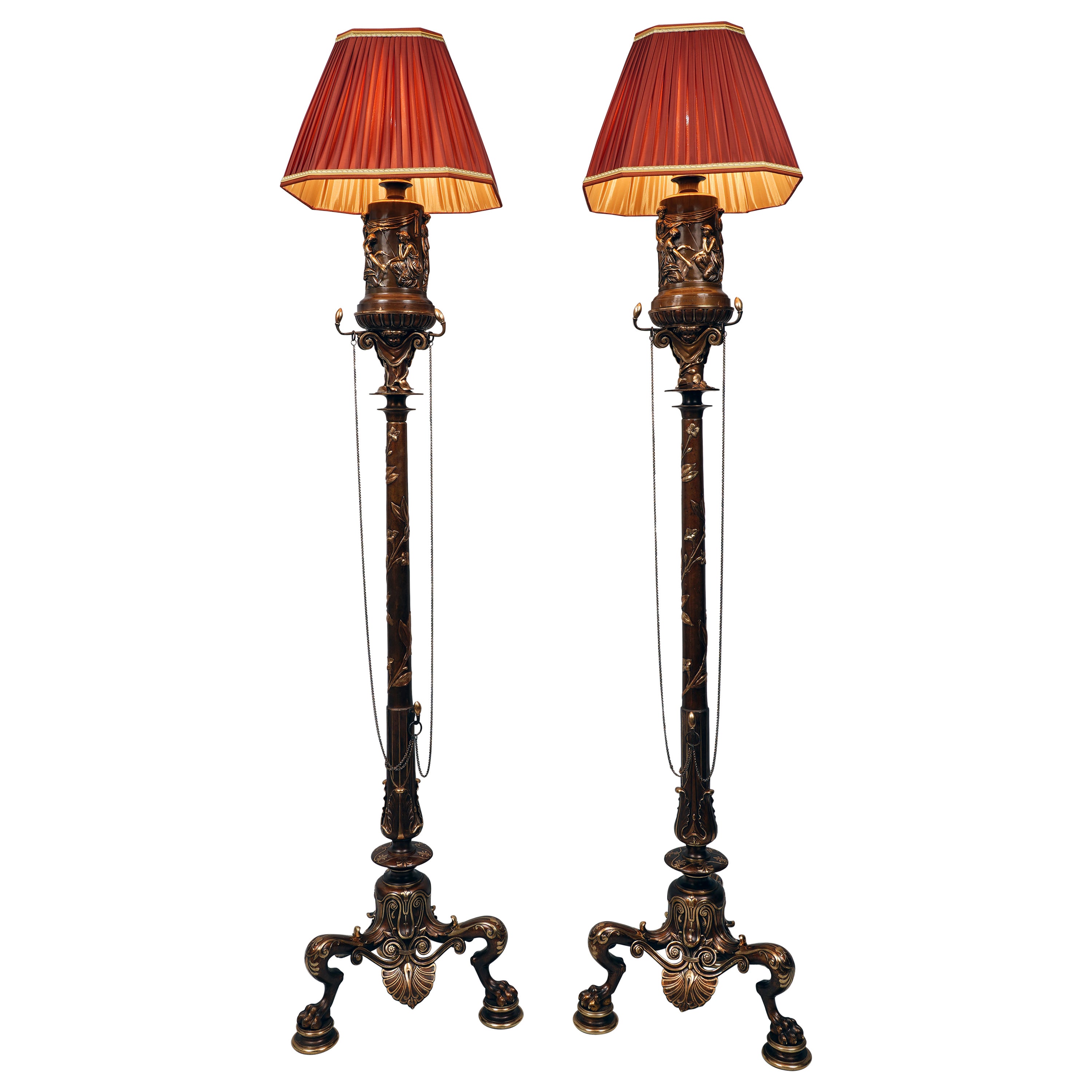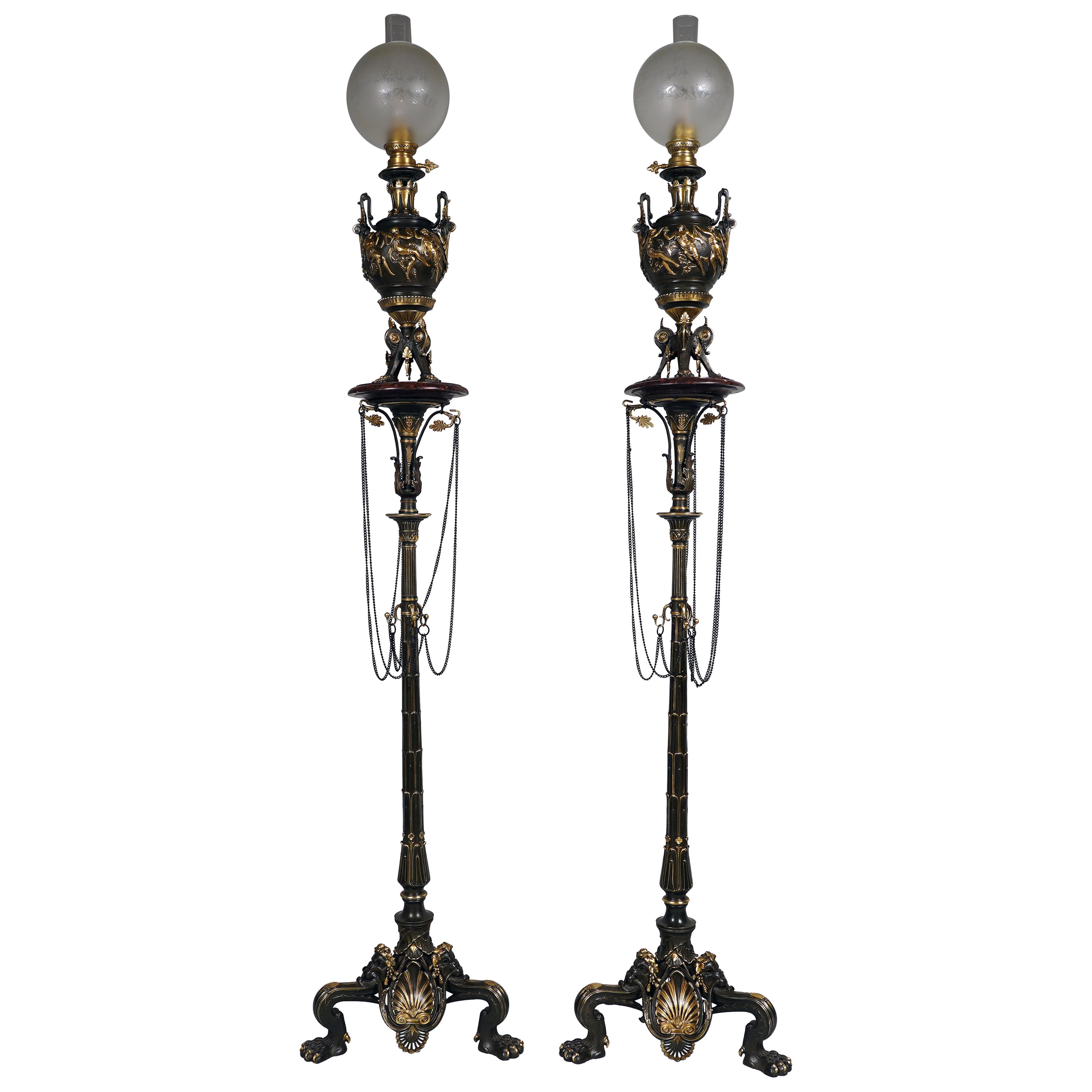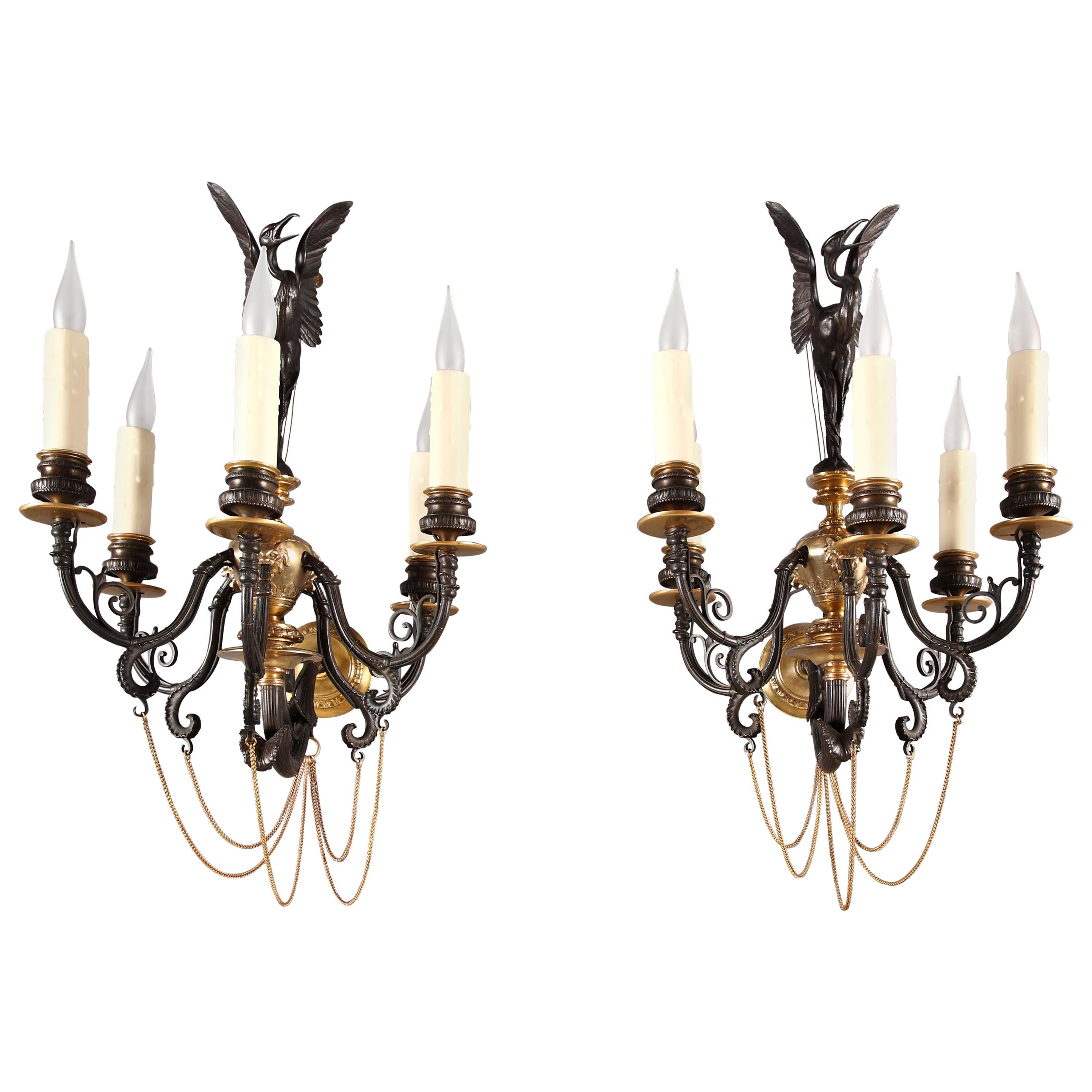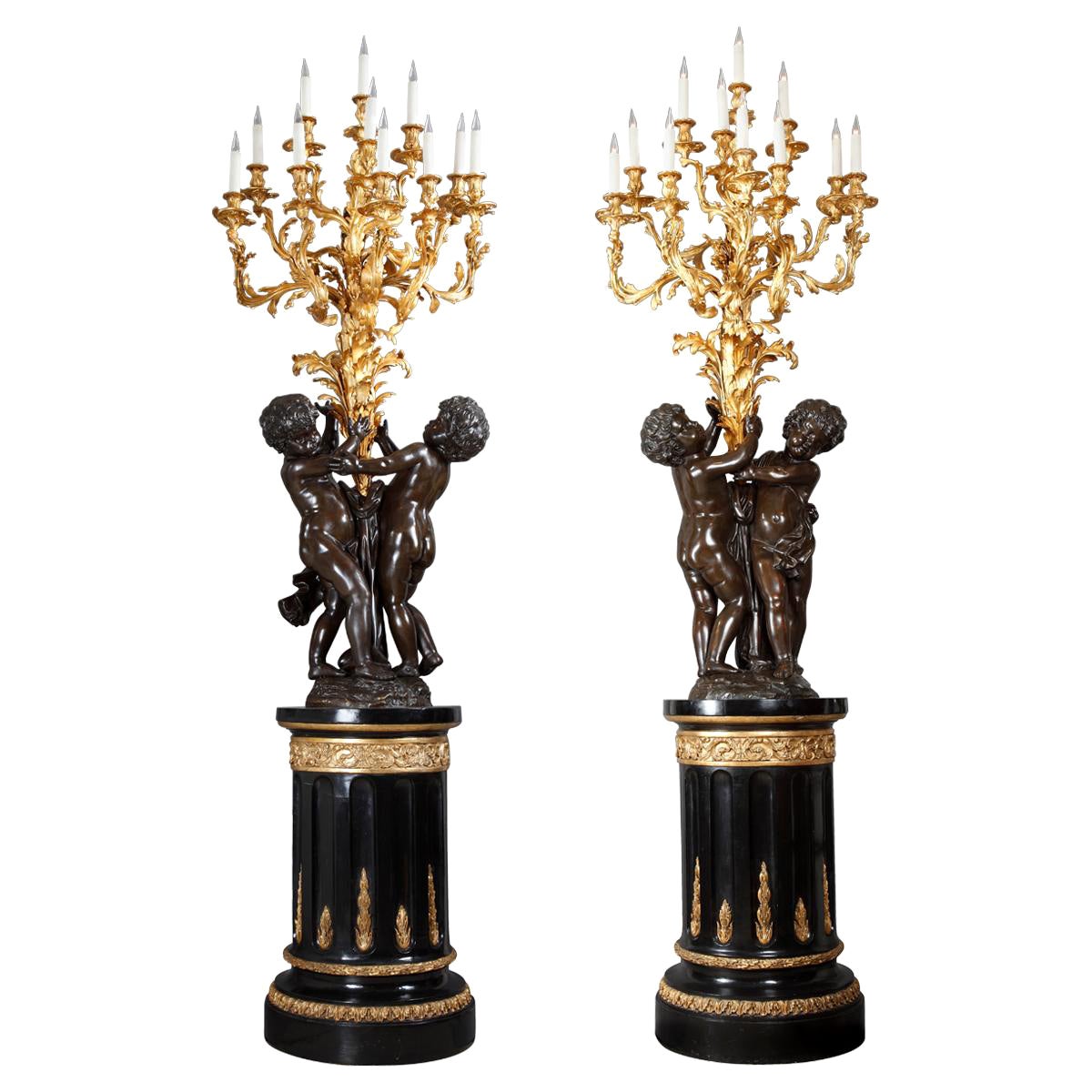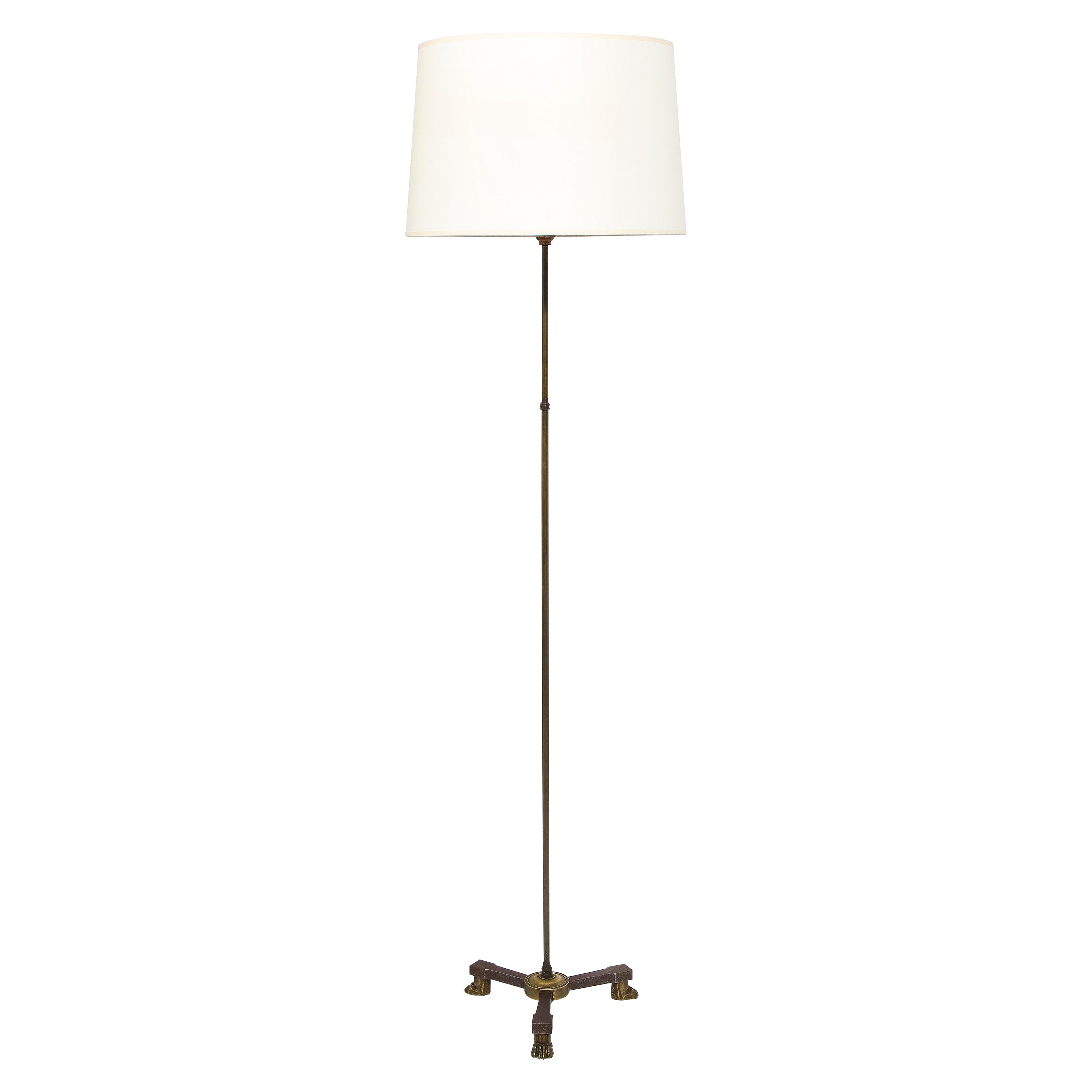Items Similar to Pair of Neo-Greek Floor Lamps Attributed to G. Servant, France, Circa 1870
Want more images or videos?
Request additional images or videos from the seller
1 of 9
Pair of Neo-Greek Floor Lamps Attributed to G. Servant, France, Circa 1870
About the Item
Rare pair of Greek style floor lamps made in patinated bronze attributed to G. Servant, each surmounted of a frosted glass globe engraved of stars and a Greek motif frieze. The body of the vase, decorated with Greek style patterns such as palmets, Greek motif frieze and water leaves, stands on a shaft decorated with deer heads. Fine chains are connected to a delicate butterfly. The set is based on tripod legs with lion claw feet alternating large palmets.
Height : 183 cm (72 in.) ; 213 cm (83 3/4 in.) with glass shades ; Diameter : 43 cm (19 2/3in.)
Georges Emile Henri Servant (1828-c.1890), who took over his father in 1855 at their foundry, rue Vieille-du-Temple, in Paris, specialized in the production of neo-Egyptian style clocks, very popular in France since 1860’s, and also the making of Greek style decorative objects. He drew considerable attention to the high quality of his bronzes at the 1855 Paris Universal Exhibition and then at the 1862 London Exhibition. At this time Servant exported up to 40% of his production, principally to the United States, where for instance, his clocks were sold with great success by Louis Tiffany Inc. or Hamann & Roche of New York. But his success came really at the 1867 Paris Universal Exhibition, where he was awarded a gold medal for his neo-Greek and Egyptian works (Les Merveilles de l’Exposition Universelle de 1867, t. II, p° 165 & 167). He was even awarded in 1874 the « Ordre national de la Légion d’Honneur », France’s hightest official mark of recognition. Servant participated once again successfully at the 1878 Paris Universal Exhibition, where he not only exhibited vases and small bronze pieces of furniture, but was also a member of the jury for the class of bronze pieces of art. He finally retired shortly before the 1889 Paris Universal Exhibition.
- Attributed to:Georges Emile Henri Servant (Maker)
- Dimensions:Height: 83.86 in (213 cm)Diameter: 16.93 in (43 cm)
- Sold As:Set of 2
- Style:Greek Revival (In the Style Of)
- Materials and Techniques:
- Place of Origin:
- Period:
- Date of Manufacture:circa 1870
- Condition:Wear consistent with age and use.
- Seller Location:PARIS, FR
- Reference Number:
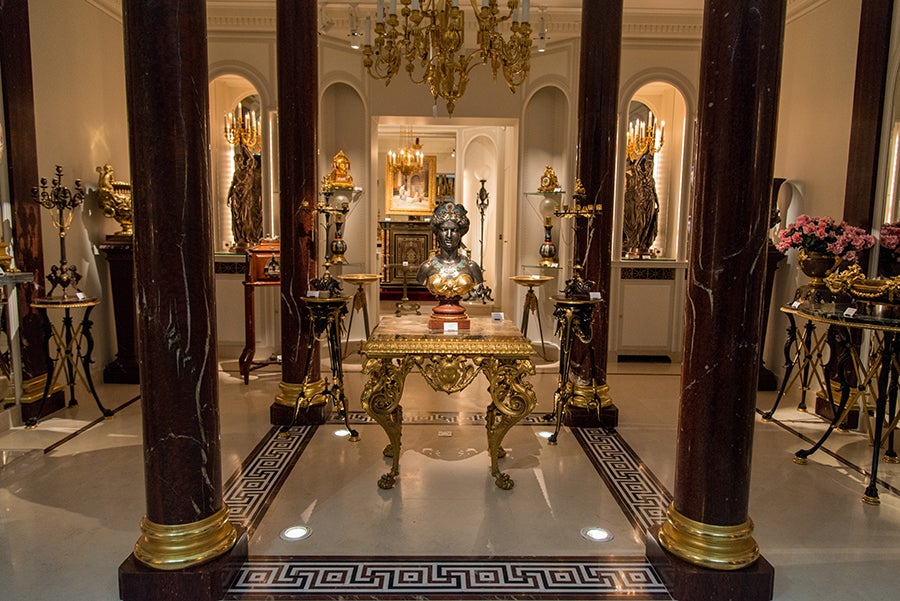
About the Seller
4.9
Vetted Seller
These experienced sellers undergo a comprehensive evaluation by our team of in-house experts.
Established in 1997
1stDibs seller since 2018
73 sales on 1stDibs
Typical response time: <1 hour
Associations
International Confederation of Art and Antique Dealers' Associations
- ShippingRetrieving quote...Ships From: PARIS, France
- Return PolicyA return for this item may be initiated within 7 days of delivery.
More From This SellerView All
- Pair of Neo-Greek Bronze Candelabras Attributed to G.Servant, France, Circa 1870By Georges Emile Henri ServantLocated in PARIS, FRRare pair of Greek style candelabras made in patinated bronze and gilded bronze, attributed to G. Servant. Each with ten light arms topped by a heron shaped extinguisher. Decorated with various Greek style motifs such palmets, pine cones ans water leaves. Standing on a small triangular architecture presenting a theatre mask and reposing on a tripod base formed with lion paw feet. Georges Emile Henri Servant (circa 1828-1890), who took over his father in 1855 at their foundry, rue Vieille-du-Temple, in Paris, specialized in the production of neo-Egyptian style clocks, very popular in France since 1860’s, and also the making of Greek style decorative objects. He drew considerable attention to the high quality of his bronzes at the 1855 Paris Universal Exhibition and then at the 1862 London Exhibition. At this time Servant exported up to 40% of his production, principally to the United States, where for instance, his clocks were sold with great success by Louis Tiffany Inc. or Hamann & Roche of New York. But his success came really at the 1867 Paris Universal Exhibition, where he was awarded a Gold Medal for his neo-Greek and Egyptian works (Les Merveilles...Category
Antique 1870s French Greek Revival Table Lamps
MaterialsBronze
- Pair of Neo-Greek Pedestals, attributed to G.Servant, France, Circa 1880By Georges Emile Henri ServantLocated in PARIS, FRPair of patinated and gilded bronze turntable pedestals with for each of them, three paw feet, headed by stylized lion muzzles, ornated with beaded chains and joined by a fine foliate stretcher. The belt is adorned by a banded frieze cast in low-relief representing an ancient scene : “The Battle of the Lapithes and the Centaurs”. These pedestals can be associated with the "Vases de Bacchus", presented by G. Servant at the 1867 Exposition Universelle, on which the similar ornamentation is applied. (Reproduced in « Merveilles de l'Exposition Universelle de 1867 », Jules Mesnard, p°167) Biography : Georges Emile Henri Servant...Category
Antique 1880s French Greek Revival Pedestals
MaterialsBronze
- Neo-Greek Silvered Bronze Bowl Attributed to G. Servant, France, circa 1880By Georges Emile Henri ServantLocated in PARIS, FRBeautiful silvered bronze neo-Greek style bowl in a circular shape, adorned on the body with female masks in the antique style and on the sides with handles in the shape of busts of ...Category
Antique 1880s French Greek Revival Decorative Bowls
MaterialsGriotte Marble, Bronze
- Pair of Neo-Greek Bronze Floor Lamps by F. Barbedienne, France, circa 1860By Ferdinand BarbedienneLocated in PARIS, FRHeight without/with lampshade : 168/185 cm (66,1 / 72,8 in.) ; Base : 43 x 43 cm (16,9 x 16,9 in.) Beautiful pair of neo-Greek floor lamps in bronze with double patina, composed of cylindrical lamps, decorated on the body with a rotating frieze representing women dressed in the Antique style weaving and spinning, surmounted by lampshades with cut sides in red pleated silk with golden braid. They are placed on pedestals from which hang thin chains attached to the slender shaft decorated with stylized leaves and flowers, resting on a tripod base decorated with large palmettes and ending in lion’s paws. The stylistic repertoire used here, composed in particular of palmettes, masks, and nymphs, evokes Greek Antiquity, as does the reuse of forms of furniture and objects such as tripods and antique vases. The rediscovery in the 18th century of the archaeological remains of Pompeii and Herculaneum allowed artists of all disciplines to draw inspiration from Antiquity while reinterpreting it. This trend did not fade and, in the 19th century, many personalities fitted out their interiors with neo-Greek furniture, as was the case for the Maison Pompéienne built in 1856 by the architect Alfred Normand (1822-1909) for Prince Napoleon, or Empress Eugénie who bought from the Maison Barbedienne pedestals inspired by antique tripods. Related work : Pedestal model presented by Maison Barbedienne at the Universal Exhibition in Paris in 1855. On this occasion, Empress Eugénie bought it for her bathroom in the Château de Saint-Cloud. This model pleased the Empress so much that she ordered two other pairs in 1858 for her boudoir in the palaces of Compiègne and Fontainebleau. (see photo attached) Photo showing a floor lamp similar to ours in Empress Eugénie’s bedroom in the Château de Compiègne (Oise), in Architecture intérieure et Décoration en France des...Category
Antique 1860s French Greek Revival Floor Lamps
MaterialsBronze
- Pair of Neo-Greek Floor Lamps Att. to Lacarrière, Delatour & Cie, France, C 1860By Lacarrière, Delatour and Co.Located in PARIS, FRMeasures : Total Height : 188,5 cm (74,2 in.) ; Base : 45 x 45 cm (17,7 x 17,7 in.) Pedestal height : 136 cm (53,5 in.) Lamp height : 52 cm (20,4 in.) Beautiful pair of neo-Greek fl...Category
Antique 1860s French Greek Revival Floor Lamps
MaterialsGriotte Marble, Bronze
- Neo-Egyptian Bronze and Marble Clock Attributed to G.Servant, France, Circa 1870By Georges Emile Henri ServantLocated in PARIS, FRA black and red marble clock in the shape of an Egyptian temple attributed to G. Servant, flanked by double columns inscribed with hieroglyphs and ornated with a winged uraeus, all made in two patina bronze. The clock is surmounted by a patinated bronze sphinx. Resting on four bronze faces wearing the nemes and terminating in lion paw feet. Georges Emile Henri Servant (circa 1828-1890) who took over his father in 1855 at their foundry, rue Vieille-du-Temple, in Paris, specialized in the production of neo-Egyptian style clocks, very popular in France since 1860s, and also the making of Greek style decorative objects. He drew considerable attention to the high quality of his bronzes at the 1855 Paris Universal Exhibition and then at the 1862 London Exhibition. At this time Servant exported up to 40% of his production, principally to the United States, where for instance, his sphinx clocks were sold with great success by Louis Tiffany Inc. or Hamann & Roche of New York (A similar clock is now exposed at the Metropolitan Museum of Art, New York). But his success came really at the 1867 Paris Universal Exhibition, where he was awarded a gold medal for his neo-Greek and Egyptian works (Les Merveilles...Category
Antique 1870s French Egyptian Revival Mantel Clocks
MaterialsMarble, Bronze
You May Also Like
- Lion Feet Bronze Neo Classical Floor Lamp Attributed to Arbus, France 1940'sBy André ArbusLocated in New York, NYRare patinated bronze lamp floor. Attributed to André Arbus. Height adjustable from 45" to 59" excluding shade. Shade for showing purposes only. ...Category
Vintage 1940s French Neoclassical Floor Lamps
MaterialsBronze
- Floor Lamp attributed to Gino Sarfatti, circa 1950By Gino SarfattiLocated in Berlin, DEFloor lamp attributed to Gino Sarfatti, Italy, circa 1950, designer unknown.Category
Vintage 1950s Italian Mid-Century Modern Floor Lamps
MaterialsBrass
- Floor lamp attributed to StilnovoBy StilnovoLocated in Lugo, ITFloor lamp attributed to Stilnovo, 1960 Brass, marble, and opal glass. Measures 103 cm by 11.5/25 cm Good Condition Thank youCategory
Vintage 1960s Italian Mid-Century Modern Floor Lamps
MaterialsMarble, Brass
- 1950s Floor Lamp Attributed to Maison Lunel FranceBy LunelLocated in London, GBThe design of this 1950s floor lamp manufactured by Maison Lunel is inspired by the Argand oil lamp invented in the 18th century by Aimé Argand and later popularized in France by a p...Category
Mid-20th Century French Mid-Century Modern Floor Lamps
MaterialsBrass, Metal
- French Deco Floor Lamp Attributed to André ArbusBy André ArbusLocated in Brooklyn, NYFrench standing lamp with tapered octagonal carved sycamore stem on solid cast bronze tripod base with stylized bronze fittings, circa 1930s.Category
Vintage 1930s French Floor Lamps
MaterialsSycamore
- 1950s Floor Lamp Attributed to Maison Lunel FranceBy LunelLocated in London, GB1950s floor lamp attributed to Maison Lunel France. The circular base is painted black with a polished brass arm finish. Each of the arms is topped with a parchment shade with a bl...Category
Mid-20th Century French Mid-Century Modern Floor Lamps
MaterialsMetal, Brass
Recently Viewed
View AllMore Ways To Browse
Greek Pair
Greek Pattern
Greek Motif
Greek Lamp
Large Floor Object
1880 French Lamp
French 19c
Pair Floor Lamp France
French Floor Lamp Pair
Pair Of French Floor Lamp
Circa Lighting Globe Lamp
French Lamp Shades Glass
Set Of 3 Lamps
Gold Floor Lamp French
Lamp Made Of Chain
Antique Lamps New York
Neo Lamp
French Antique Floor Lamp

